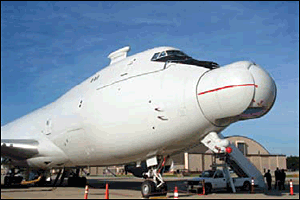ST. LOUIS, July 20, 2007 -- A key airborne laser (ABL) flight test has demonstrated the weapon system's ability to actively track an airborne target, compensate for atmospheric turbulence and fire a surrogate for its missile-destroying high-energy laser.
During a test performed last week by ABL industry partners Boeing, Northrup Grumman and Lockheed Martin and the US Missile Defense Agency, the modified Boeing 747-400F took off from Edwards Air Force Base, Calif., and used its infrared (IR) sensors and its track illuminator laser (TILL) to find and track an instrumented target board located on the US Air Force's NC-135E Big Crow test aircraft.
 The Big Crow then fired its beacon laser at the ABL aircraft, which measured and compensated for laser beam distortion caused by the atmosphere. The system then fired a surrogate high-energy laser (SHEL) at the Big Crow target board to simulate shooting down a missile. The flight test demonstrated the entire engagement sequence, from target acquisition to pointing and firing the SHEL, except for the ABL's beacon illuminator laser.
The Big Crow then fired its beacon laser at the ABL aircraft, which measured and compensated for laser beam distortion caused by the atmosphere. The system then fired a surrogate high-energy laser (SHEL) at the Big Crow target board to simulate shooting down a missile. The flight test demonstrated the entire engagement sequence, from target acquisition to pointing and firing the SHEL, except for the ABL's beacon illuminator laser.
The ABL program is placing a high-energy, megawatt-class chemical oxygen iodine laser (COIL) and a highly sophisticated beam control/fire control and battle management systems on the modified aircraft to detect, track and destroy ballistic missiles in their boost phase of flight. ABL also can pass along information on launch sites, target tracks and predicted impact points to other elements of the ballistic missile defense system.
A large turret on the airplane’s nose gives the ABL its distinctive appearance. The turret points the laser beam at the target so the aircraft does not have to be turned to fire at a missile. The back half of the aircraft will contain the world’s largest mobile laser, which consists of six modules, each the size of a Chevy Suburban sport utility vehicle. The front half already contains the beam control/fire control system, which compares in size and sophistication to the Hubble Space Telescope.
Pat Shanahan, vice president and general manager of Boeing Missile Defense Systems, in a statement, said, "We have now demonstrated most of the steps needed for the airborne laser to engage a threat missile and deliver precise and lethal effects against it."
The ABL fired the TILL at the Big Crow target board for the first time in March. The latest test demonstrated its ability to make a transition from passive to active tracking of a simulated missile plume to active, by "walking" the TILL beam to the nose of the missile and using the TILL light returning from the edge of missile for precision tracking and to determine where to point the SHEL on the target. It also performed atmospheric turbulence compensation.
The high-power chemical laser has completed rigorous ground testing at Edwards Air Force Base and is being prepared for installation. In upcoming flight tests, the ABL will again demonstrate the engagement sequence, using the return from its BILL instead of the Big Crow's beacon laser to measure atmospheric distortion. After these flight tests, the actual Northrop Grumman-built high-energy laser will be installed in the aircraft to prepare for the first intercept test against an in-flight ballistic missile in 2009.
“The COIL has already proved in ground tests that it can achieve the duration and power levels needed to destroy a ballistic missile,” said Guy Renard, Northrop Grumman’s ABL program manager. “In 2009, we will demonstrate this capability in the air against an actual boosting ballistic missile.”
Boeing, the prime contractor and overal systems integrator for the ABL, is providing the modified aircraft and the battle management system. Northrop Grumman is supplying the high-energy laser and the beacon illuminator laser, and Lockheed Martin is responsible for the nose-mounted turret and the beam control/fire control system.
For more information, visit: www.boeing.com